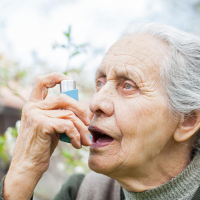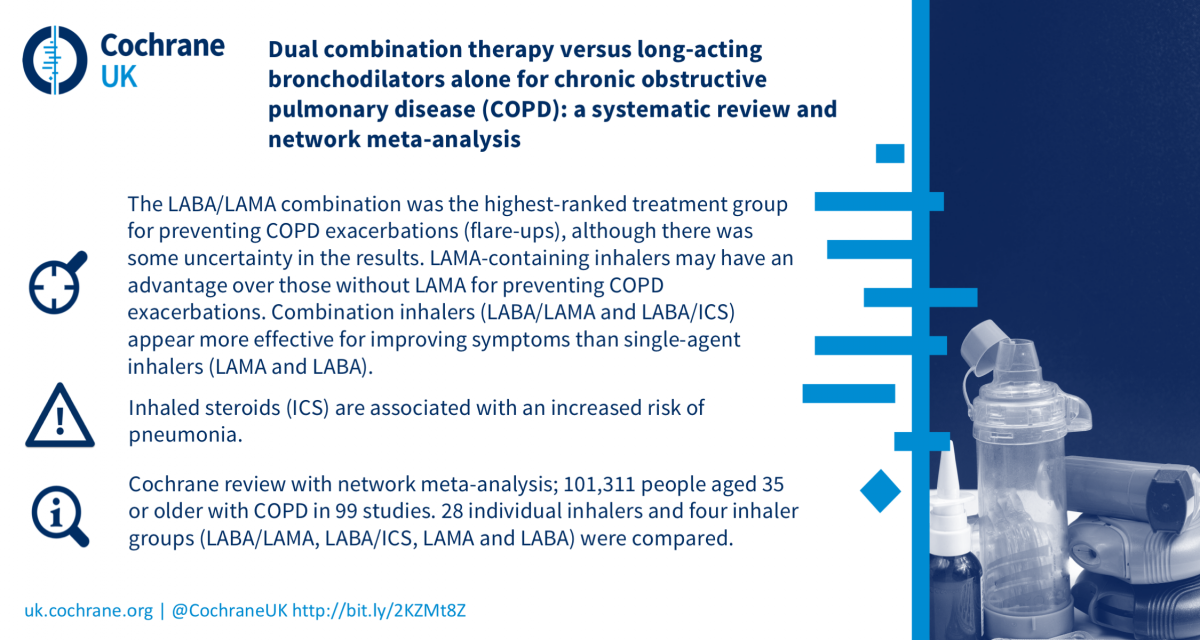
This recently published Cochrane Review assessed which long-acting inhalers are the most effective and safest for people with advanced chronic obstructive pulmonary disease (COPD.)
Chronic obstructive lung disease (COPD) is usually caused by smoking or other airway irritants. COPD damages the lungs and causes airways to narrow which makes it difficult to breathe. The disease accounts for more than three million deaths annually and is the third leading cause of death world-wide, it is also a major cause of disability and hospitalisation. Quality of life can be poor as people find it hard to carry out everyday tasks
There are two types of inhalers for COPD: rescue and maintenance. A rescue inhaler is short- and fast-acting, and used as needed for quick relief of symptoms, whereas a maintenance inhaler is long-acting and used on a daily basis to relieve daily symptoms and reduce flare-ups. The long-acting inhalers are usually reserved for more advanced COPD.
Does it matter which long-acting inhaler is used in people with advanced COPD?
Commonly used maintenance inhalers are grouped into four different groups: long-acting beta2-agonists (LABAs); long-acting muscarinic antagonists (LAMAs); LABA/inhaled corticosteroid (ICS) combinations; and LABA/LAMA combinations. Combination inhalers are usually reserved for individuals whose single-maintenance inhaler, such as LAMA or LABA fails.
There are not many head-to-head comparisons to determine which treatment group or individual inhaler is better compared to the others. Preventing severe flare-ups and hospital admissions is especially important to people with COPD, healthcare providers, policy makers and society.
How did the review group answer the question?
We collected and analysed data from 99 studies, including a total of 101,311 participants with advanced COPD, using a special method called network meta-analysis, which enabled us to simultaneously compare the four inhaler groups and 28 individual inhalers.
What did it find?
- The LABA/LAMA combination was the best treatment, followed by LAMA, in preventing flare-ups although there was some uncertainty in the results.
- Combination inhalers (LABA/LAMA and LABA/ICS), are more effective for controlling symptoms than single-agent therapies (LAMA and LABA), in general.
- The LABA/LAMA combination was better than LABA/ICS combination, especially in people with a prior episode of flare-ups.
- The LABA/ICS combination had a higher incidence of severe pneumonia compared to the others.
- We did not find a difference in benefits and harms, including side effects, among individual inhalers within the same treatment groups.

Conclusion
The LABA/LAMA combination is likely the best treatment in preventing COPD flare-ups. LAMA-containing inhalers appear to have an advantage over those without LAMA for preventing flare-ups.
Combination inhalers (LABA/LAMA and LABA/ICS), appear more effective for controlling symptoms than single-agent therapies (LAMA and LABA). Inhaled steroids carry an increased risk of pneumonia.
Yuji Oba, lead author of this Cochrane review said, “ There are a range of different treatments for COPD, and this review provides a comprehensive assessment of how effective they are at preventing flare ups of COPD, managing symptoms and improving quality of life, but it also looks at important harms including the risk of pneumonia. The findings of the network meta-analysis feed in to guidelines published by NICE and are testament to a strong collaboration between Cochrane Airways group and the guideline group who have developed guidance on managing COPD.”
